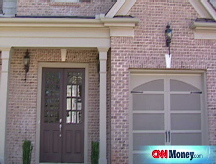Housing fix backfires
A new law was supposed to make it easier for buyers in expensive markets to get affordable loans. Instead, rates are going up for everyone.
| 30 yr fixed | 3.80% |
| 15 yr fixed | 3.20% |
| 5/1 ARM | 3.84% |
| 30 yr refi | 3.82% |
| 15 yr refi | 3.20% |
NEW YORK (Money Magazine) -- Back in February, Congress passed into law a quick fix for the housing market. Unfortunately, it hasn't done much good.
As part of the economic stimulus plan, lawmakers raised the limit on the size of home loans mortgage giants Fannie Mae and Freddie Mac can guarantee, from $417,000 to as high as $729,750 in some of the most expensive U.S. markets. That was supposed to bring down mortgage rates on jumbo loans and help goose sales in cities across the country - mostly on the East and West coasts - where even outhouses go for close to half a mil.
So just how much help has this change been for homeowners? Not much. Six months ago, the rate on a $500,000 30-year fixed mortgage was 6.73%. Today the rate today is only slightly lower at 6.69%. No surprise then that the housing market is still stuck in reverse.
The problem has a lot to do with news that has been bedeviling Fannie (FNM, Fortune 500) and Freddie (FRE, Fortune 500). Basically, the mortgage giants have been racking up losses faster than Brangelina's adding children. And the market grows more convinced every day that these two so-called government-sponsored entities will in fact need to bailed out with taxpayer funds, according to a plan recently proposed by Treasury Secretary Henry Paulson and passed into law by Congress.
Fannie and Freddie play a critical role in the mortgage market by buying loans from banks, securitizing them and then selling those securities to investors. That gives banks more cash to lend to consumers, which keeps home buying affordable.
The catch: Fannie and Freddie could until recently only buy loans up to $417,000. That meant it was harder and more expensive for home buyers to get a loan in areas where the median priced home is north of $500,000, which is why Congress elected to raise that $417,000 cap substantially.
The idea was to narrow the spread between the interest rates for buyers taking out loans of less than $417,000, and those borrowing between $417,000 and roughly $730,000. By February, the rate on a loan over $417,000 was as much as 1.5 percentage points higher than loans beneath that cap, according to mortgage industry research firm HSH Associates.
But rates haven't fallen for those hoping to get a larger mortgage, and they've actually risen for everyone else. The average rate for a mortgage of $417,000 or less is now at 6.57%, while loans larger than that have rates about 0.12 of a percentage point higher. Sure, the spread narrowed, but only because rates are going up for everyone.
Several factors are at work. Since Fannie and Freddie look shakier than ever, fewer investors are willing to buy their bonds - even with the government's guarantee. And the raised caps forced the mortgage giants to spread their limited capital across a much larger market of mortgages.
Add in the new fees that Fannie and Freddie have tacked on to their mortgages since the housing crisis hit, and most borrowers are paying more than they were six months ago.
"Really the way it has translated is that by the time it gets to the borrower they get no real savings," says Steve Habetz, who runs Threshold Mortgage in Westport, Conn.
And don't look for mortgage rates to come down anytime soon. Fannie and Freddie need to build their capital back up. That means make as much money as possible. So even if their borrowing rates come down, don't expect them to pass that savings to you.
"There are a lot of moving parts here, and none of them are moving in favor of lower mortgage rates," says Bob Auwaerter, head of the fixed income group at Vanguard.
In the meantime, here are some steps you can take to lower your borrowing costs:
Check out smaller banks. Since local lenders have not being hit as hard by the mortgage mess - they didn't make as many sub-prime or option-ARM loans - they are the ones who can offer the best deals right now.
Try for a home equity line of credit. HELOCs can be hard to get right now, but they are cheaper than doing a complete refinance. Recently, the average rate on a HELOC was 5.73%, a point lower than the new jumbo loans. What's more, HELOC generally have no upfront fees. The rub is that HELOCs are adjustable, but with the economy looking sluggish it's a good bet interest rates won't rise soon.
Improve your credit score. It used to be that people with a 620 or higher qualified for Freddie and Fannie's best rates. As of Oct. 1, you will need at least a 720 credit score. And there may be even more rate breaks for higher credit score borrowers. The quickest way to boost your score is to get a credit report and correct any errors. Don't be surprised to see a few.
Spend more time shopping around for a mortgage. With Fannie and Freddie able to buy fewer mortgages, they have less ability to dictate prices. That means mortgage interest rates are going to vary more from bank to bank. So get rate quotes from at least five lenders before you decide you have found the lowest rates. It is extra work, but it will be worth it. After all, as we should have learned by now, counting for some government plan to lower interest rates is silly. ![]()




